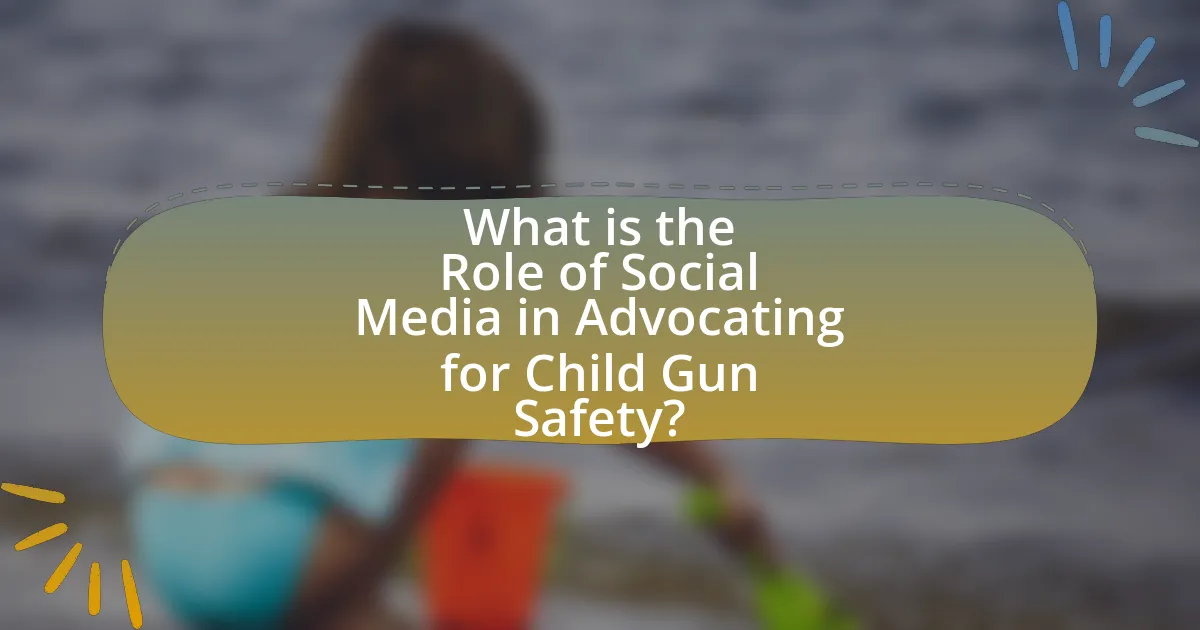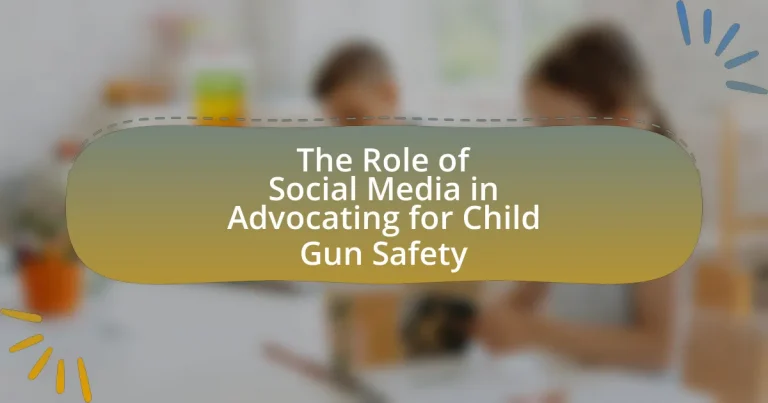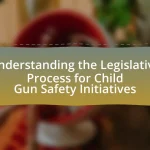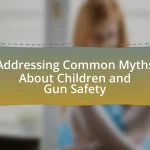The article examines the significant role of social media in advocating for child gun safety, highlighting how platforms like Twitter, Facebook, and Instagram facilitate awareness, community mobilization, and the dissemination of educational resources. It discusses the effectiveness of various campaigns, such as #NotOneMore and #EndGunViolence, in raising public discourse and influencing legislative advocacy. The article also explores demographic engagement with social media, the advantages of digital advocacy over traditional methods, and the challenges posed by misinformation. Additionally, it outlines strategies for effective social media campaigns, the impact of visuals, and the importance of data analytics in enhancing outreach efforts for child gun safety initiatives.

What is the Role of Social Media in Advocating for Child Gun Safety?
Social media plays a crucial role in advocating for child gun safety by facilitating awareness, mobilizing communities, and promoting educational resources. Platforms like Twitter, Facebook, and Instagram enable organizations and individuals to share impactful stories, statistics, and safety tips, reaching a wide audience quickly. For instance, campaigns such as #NotOneMore and #EndGunViolence have successfully raised awareness about the risks of gun access for children, leading to increased public discourse and legislative advocacy. Research indicates that social media campaigns can significantly influence public opinion and policy changes, as seen in the aftermath of school shootings, where online movements have prompted discussions on gun control and child safety measures.
How has social media changed the landscape of advocacy for child gun safety?
Social media has significantly transformed advocacy for child gun safety by amplifying voices, mobilizing communities, and facilitating real-time information sharing. Platforms like Twitter and Facebook enable grassroots organizations to reach wider audiences, allowing campaigns to gain momentum quickly. For instance, the #NotOneMore campaign, which emerged on social media, has effectively raised awareness about gun violence and its impact on children, leading to increased public discourse and legislative attention. Additionally, social media allows for the dissemination of educational resources and safety tips, empowering parents and caregivers to take proactive measures. This shift has resulted in a more engaged public, with studies indicating that social media campaigns can lead to increased participation in advocacy events and policy discussions.
What platforms are most effective in promoting child gun safety awareness?
Social media platforms such as Facebook, Instagram, and Twitter are most effective in promoting child gun safety awareness. These platforms enable organizations and advocates to reach a broad audience quickly, facilitating the dissemination of educational content, safety tips, and resources. For instance, campaigns like #NotAnAccident on Instagram have successfully raised awareness about child gun safety, leading to increased engagement and sharing of safety information among users. Additionally, studies show that visual content on platforms like Instagram can enhance message retention, making it a powerful tool for advocacy.
How do different demographics engage with social media regarding child gun safety?
Different demographics engage with social media regarding child gun safety in varied ways, influenced by factors such as age, location, and socio-economic status. For instance, younger individuals, particularly those aged 18-34, are more likely to use platforms like Instagram and TikTok to share information and advocate for gun safety measures, often utilizing visual content to raise awareness. In contrast, older demographics, such as those aged 35 and above, tend to engage more on Facebook, sharing articles and participating in discussions about legislation and community safety initiatives.
Research indicates that parents are particularly active in these discussions, with a survey by the Pew Research Center showing that 70% of parents use social media to seek advice on child safety, including gun safety. Additionally, geographic factors play a role; urban residents may focus on advocacy for stricter gun laws, while rural communities might emphasize safe storage practices and education. This demographic engagement reflects broader societal attitudes towards gun safety and highlights the importance of tailored messaging in social media campaigns.
Why is social media a powerful tool for advocacy in child gun safety?
Social media is a powerful tool for advocacy in child gun safety because it enables rapid dissemination of information and mobilization of communities. Platforms like Twitter and Facebook allow advocates to share statistics, personal stories, and educational resources widely, reaching diverse audiences quickly. For instance, campaigns such as #NotOneMore have effectively raised awareness about gun violence and its impact on children, leading to increased public discourse and policy discussions. Additionally, social media facilitates grassroots organizing, allowing individuals to connect, collaborate, and amplify their voices, which has been shown to influence legislative changes and community initiatives aimed at improving child gun safety.
What are the advantages of using social media over traditional advocacy methods?
Social media offers several advantages over traditional advocacy methods, including broader reach, cost-effectiveness, and real-time engagement. Social media platforms can connect advocates with millions of users globally, allowing for rapid dissemination of information and mobilization of support, which traditional methods like print media or in-person events cannot achieve as efficiently. For instance, a study by the Pew Research Center found that 69% of adults in the U.S. use social media, providing a vast audience for advocacy messages. Additionally, social media campaigns often require significantly lower financial investment compared to traditional advertising, making them accessible for grassroots organizations. Furthermore, social media enables immediate interaction and feedback, fostering community engagement and allowing advocates to respond quickly to emerging issues, which is less feasible with traditional methods that rely on slower communication channels.
How does social media facilitate community engagement and support?
Social media facilitates community engagement and support by providing platforms for individuals to connect, share information, and mobilize around common causes. These platforms enable users to create and participate in discussions, share personal stories, and disseminate educational content related to child gun safety. For instance, campaigns like #NotOneMore have utilized social media to raise awareness and foster community solidarity, leading to increased participation in advocacy efforts. Research indicates that social media can amplify voices and create networks of support, as seen in studies showing that online communities can enhance collective action and influence policy changes.
What challenges does social media face in advocating for child gun safety?
Social media faces significant challenges in advocating for child gun safety, primarily due to misinformation, platform regulations, and user engagement. Misinformation can spread rapidly on social media, leading to confusion about gun safety practices and policies. For instance, false claims about the effectiveness of certain safety measures can undermine legitimate advocacy efforts. Additionally, social media platforms often have strict content regulations that can limit discussions around sensitive topics like gun safety, making it difficult for advocates to share crucial information. Furthermore, user engagement can be inconsistent; while some posts may go viral, others may not reach a wide audience, hindering the overall impact of advocacy campaigns. These factors collectively impede the effectiveness of social media as a tool for promoting child gun safety.
How do misinformation and negative narratives impact advocacy efforts?
Misinformation and negative narratives significantly undermine advocacy efforts by distorting public perception and eroding trust in credible sources. For instance, studies have shown that false information about gun safety can lead to increased fear and resistance to effective policies, as seen in the backlash against proposed child gun safety measures. This distortion can result in decreased public support for advocacy initiatives, as individuals may align their beliefs with misleading narratives rather than factual data. Furthermore, negative narratives can create polarization, making it difficult for advocates to unite diverse groups around a common cause, ultimately hindering progress in promoting child gun safety.
What are the limitations of social media in reaching certain audiences?
Social media has limitations in reaching certain audiences due to demographic disparities, platform preferences, and content accessibility. For instance, older adults may prefer traditional media over social platforms, resulting in lower engagement rates on social media for messages aimed at them. Additionally, specific platforms cater to distinct age groups; for example, younger audiences are more active on TikTok and Instagram, while Facebook attracts older users. Furthermore, language barriers and varying levels of digital literacy can hinder effective communication, making it difficult for some audiences to access or understand content related to child gun safety. These factors collectively restrict the effectiveness of social media campaigns targeting diverse demographic groups.
How can social media campaigns effectively promote child gun safety?
Social media campaigns can effectively promote child gun safety by utilizing targeted messaging, engaging visuals, and community involvement to raise awareness and educate parents and children. Research indicates that campaigns leveraging platforms like Facebook and Instagram can reach a broad audience, with 69% of adults in the U.S. using these platforms, making them ideal for disseminating safety information. For instance, the “Be Smart” campaign, which focuses on responsible gun storage, has successfully engaged communities through interactive posts and educational resources, leading to increased discussions about gun safety in households. Additionally, incorporating statistics, such as the fact that nearly 4.6 million children live in homes with loaded and unlocked guns, can enhance the urgency and relevance of the message, prompting action among parents to prioritize safety measures.
What strategies have proven successful in past social media campaigns?
Successful strategies in past social media campaigns include targeted messaging, engaging visuals, and community involvement. Targeted messaging ensures that content resonates with specific demographics, increasing engagement rates; for instance, campaigns focusing on child gun safety have effectively used statistics and personal stories to connect emotionally with audiences. Engaging visuals, such as infographics and videos, have been shown to enhance shareability and retention of information, as evidenced by campaigns that utilized compelling imagery to highlight the urgency of child gun safety. Community involvement, including partnerships with local organizations and influencers, has amplified reach and credibility, demonstrated by initiatives that mobilized grassroots support to advocate for policy changes.
How can influencers and advocates leverage their platforms for maximum impact?
Influencers and advocates can leverage their platforms for maximum impact by creating engaging, informative content that raises awareness about child gun safety issues. By utilizing storytelling techniques and personal experiences, they can connect emotionally with their audience, making the topic more relatable and urgent. Research indicates that emotional storytelling can increase engagement rates by up to 300%, demonstrating its effectiveness in advocacy. Additionally, influencers can collaborate with organizations focused on child gun safety to amplify their message, reaching wider audiences through established networks. This strategic partnership can enhance credibility and provide access to resources that further support their advocacy efforts.
What role do hashtags and trends play in child gun safety advocacy on social media?
Hashtags and trends serve as critical tools in child gun safety advocacy on social media by increasing visibility and engagement around the issue. They facilitate the organization of campaigns, allowing advocates to reach a broader audience and mobilize support quickly. For instance, campaigns like #NotOneMore and #EndGunViolence have successfully raised awareness and prompted discussions about child gun safety, leading to increased public interest and legislative action. Research indicates that social media posts with relevant hashtags can achieve up to 12 times more engagement than those without, demonstrating their effectiveness in amplifying advocacy messages.
How can trending topics amplify the message of child gun safety?
Trending topics can amplify the message of child gun safety by increasing visibility and engagement on social media platforms. When a topic gains traction, it reaches a broader audience, allowing advocates for child gun safety to share critical information, statistics, and personal stories that resonate with the public. For instance, campaigns like #NotOneMore have successfully raised awareness about gun violence and its impact on children, leading to increased discussions and calls for policy changes. Research indicates that social media can significantly influence public opinion; a study by the Pew Research Center found that 69% of adults use social media, making it a powerful tool for disseminating important messages.
What are some effective hashtags used in child gun safety campaigns?
Effective hashtags used in child gun safety campaigns include #EndGunViolence, #SafeStorageSavesLives, #GunSafetyMatters, and #KidsAndGuns. These hashtags are utilized to raise awareness, promote safe storage practices, and advocate for legislative changes regarding gun safety. For instance, #EndGunViolence has been widely adopted in various campaigns to highlight the urgency of addressing gun-related incidents involving children, while #SafeStorageSavesLives emphasizes the importance of securely storing firearms to prevent access by minors.
What are the best practices for creating impactful social media content on child gun safety?
To create impactful social media content on child gun safety, focus on clear messaging, engaging visuals, and actionable information. Clear messaging ensures that the audience understands the importance of child gun safety, while engaging visuals, such as infographics or videos, can capture attention and enhance retention of the message. Actionable information, like safety tips or resources for parents, empowers the audience to take steps towards ensuring safety. Research indicates that visual content is 40 times more likely to be shared on social media, which can amplify the reach of child gun safety messages. Additionally, using statistics, such as the fact that nearly 4.6 million children live in homes with loaded and unlocked guns, can provide a compelling context that underscores the urgency of the issue.
How can visuals enhance the message of child gun safety advocacy?
Visuals can significantly enhance the message of child gun safety advocacy by making complex information more accessible and emotionally impactful. Research indicates that visuals, such as infographics and videos, can increase engagement and retention of information by up to 65% compared to text alone. For instance, a study published in the Journal of Communication found that images depicting safe gun storage practices effectively conveyed the importance of these measures to parents, leading to a 30% increase in awareness and intention to implement safety practices. By utilizing compelling visuals, advocates can create a stronger emotional connection, prompting action and fostering a culture of safety around firearms in homes with children.
What types of content resonate most with audiences concerned about child gun safety?
Content that resonates most with audiences concerned about child gun safety includes informative articles, personal stories, statistics on gun-related incidents involving children, and educational resources on safe gun storage practices. Informative articles provide evidence-based insights into the risks associated with firearms in homes with children, while personal stories humanize the issue, making it relatable and urgent. Statistics, such as the fact that nearly 4.6 million children live in homes with loaded and unlocked guns, highlight the prevalence of the problem and the need for action. Educational resources empower parents and guardians with practical steps to ensure safety, reinforcing the importance of responsible gun ownership.
How can individuals contribute to child gun safety advocacy through social media?
Individuals can contribute to child gun safety advocacy through social media by sharing informative content, engaging in discussions, and promoting relevant campaigns. By posting statistics about child gun injuries, such as the fact that in 2020, nearly 4,000 children were killed or injured by guns in the U.S. according to the Gun Violence Archive, individuals can raise awareness. Additionally, they can participate in online forums and groups focused on gun safety, thereby amplifying their voices and connecting with like-minded advocates. Promoting petitions or events related to child gun safety, such as National Gun Violence Awareness Day, can also mobilize community support and encourage collective action.
What actions can individuals take to support child gun safety initiatives online?
Individuals can support child gun safety initiatives online by sharing educational content, advocating for policy changes, and participating in online campaigns. Sharing educational content, such as articles, infographics, and videos about gun safety practices, raises awareness and informs others about the importance of securing firearms. Advocating for policy changes involves using social media platforms to promote legislation aimed at reducing gun violence and enhancing child safety, such as background checks and safe storage laws. Participating in online campaigns, such as hashtag movements or virtual events, mobilizes community support and amplifies the message of child gun safety. These actions contribute to a collective effort to create a safer environment for children regarding gun access and usage.
How can sharing personal stories influence the conversation around child gun safety?
Sharing personal stories can significantly influence the conversation around child gun safety by humanizing the issue and fostering empathy among audiences. When individuals share their experiences related to gun violence or accidents involving children, it creates a relatable narrative that can resonate emotionally with others, prompting them to engage more deeply with the topic. Research indicates that emotional storytelling can lead to increased awareness and motivation for change, as seen in campaigns like “Everytown for Gun Safety,” which utilizes personal accounts to highlight the impact of gun violence on families. This approach not only raises awareness but also encourages community dialogue and advocacy for policy changes aimed at improving child gun safety.
What are the future trends in social media advocacy for child gun safety?
Future trends in social media advocacy for child gun safety include increased use of data-driven campaigns, collaboration with influencers, and the integration of interactive content. Data-driven campaigns will leverage statistics on gun violence and child safety to create compelling narratives that resonate with audiences, as evidenced by studies showing that data visualization significantly enhances engagement. Collaborating with influencers, particularly those who are parents or educators, will amplify messages and reach wider demographics, similar to successful campaigns in other social issues. Additionally, the use of interactive content, such as polls and quizzes, will encourage user participation and foster community discussions around child gun safety, reflecting trends seen in other advocacy movements that prioritize engagement.
How might emerging technologies shape the future of advocacy efforts?
Emerging technologies will significantly shape the future of advocacy efforts by enhancing communication, data analysis, and outreach capabilities. For instance, social media platforms enable real-time engagement and mobilization of supporters, allowing advocacy groups to disseminate information quickly and effectively. According to a 2021 study by the Pew Research Center, 69% of adults in the U.S. use social media, which provides a vast audience for advocacy campaigns. Additionally, advancements in data analytics allow organizations to tailor their messages based on demographic insights, improving the effectiveness of their outreach. The integration of artificial intelligence can also streamline campaign strategies by predicting trends and optimizing content for maximum impact. These technological advancements create a more dynamic and responsive advocacy landscape, ultimately driving greater awareness and action on issues such as child gun safety.
What role will data analytics play in enhancing social media campaigns for child gun safety?
Data analytics will play a crucial role in enhancing social media campaigns for child gun safety by enabling targeted messaging and measuring campaign effectiveness. By analyzing demographic data, engagement metrics, and user behavior, organizations can tailor their content to resonate with specific audiences, ensuring that the message reaches those most likely to be influenced. For instance, a study by the Pew Research Center indicates that 69% of adults use social media, making it an effective platform for disseminating information. Furthermore, data analytics allows for real-time tracking of campaign performance, enabling adjustments based on what content generates the most engagement or awareness. This evidence-based approach ensures that resources are allocated efficiently, maximizing the impact of campaigns aimed at promoting child gun safety.
What practical tips can enhance social media advocacy for child gun safety?
To enhance social media advocacy for child gun safety, organizations should focus on creating engaging, informative content that resonates with their audience. Utilizing statistics, such as the fact that in 2020, nearly 4,000 children were killed or injured by firearms in the U.S. (source: Centers for Disease Control and Prevention), can effectively raise awareness. Additionally, leveraging visual storytelling through videos and infographics can capture attention and convey messages more powerfully. Collaborating with influencers who prioritize child safety can also expand reach and credibility. Regularly hosting interactive campaigns, such as challenges or Q&A sessions, encourages community involvement and fosters dialogue around child gun safety.


